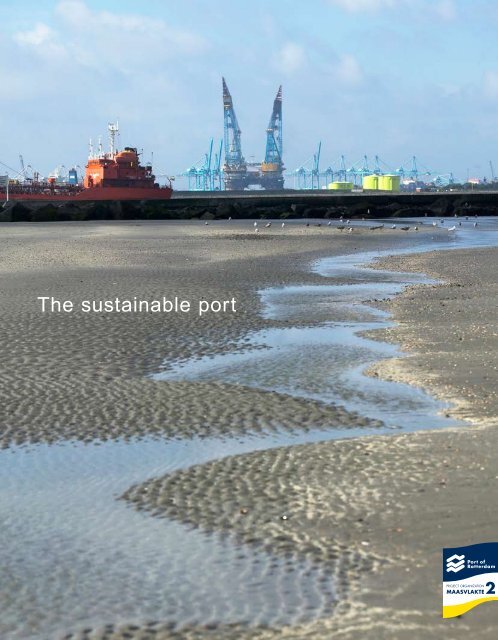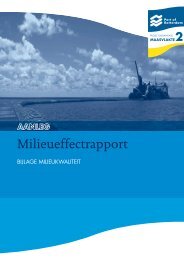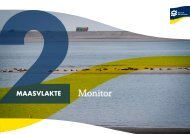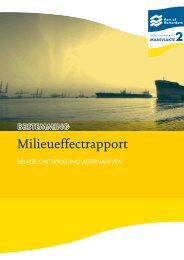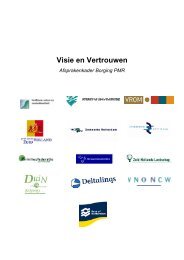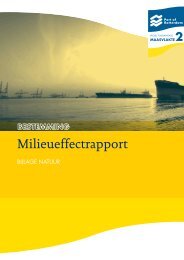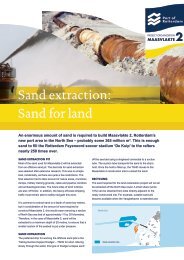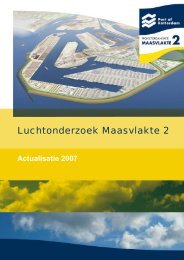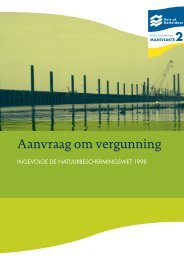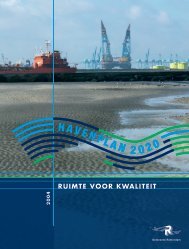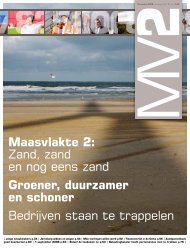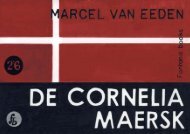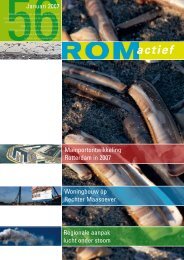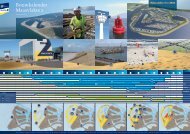Maasvlakte 2 The sustainable port (pdf, 6427Kb)
Maasvlakte 2 The sustainable port (pdf, 6427Kb)
Maasvlakte 2 The sustainable port (pdf, 6427Kb)
- No tags were found...
Create successful ePaper yourself
Turn your PDF publications into a flip-book with our unique Google optimized e-Paper software.
FOREWORD‘Create your own future’. For me,this slogan, which we used to attractnew container companies to thearea, captures the essence of the<strong>Maasvlakte</strong> 2 project. In aneconomic sense, the expansion iscrucial for maintaining Rotterdam’scurrent status as a leadingworld-class <strong>port</strong>. Doing nothingwould jeopardise the future of thedock area and those who depend onit. We hope to retain full control overour own future. At the same time,we are aware of the degree to whichwe draw on the quality of life forfuture generations. We will beintervening in local nature andintroducing extra economic activity.This will have an environmentalimpact on an area that up to now didnot accommodate any <strong>port</strong> activities.That is why we have made aconscious, unambiguous investmentin <strong>sustainable</strong> development, in anexpansion that has a strong focuson quality of life and good workingconditions, both now and in thefuture. What we have alreadylearnt at this stage is that there isno reason why environmentalbenefits and economicdevelopments cannot go hand inhand. Furthermore, our choice forsustainability results in innovativesolutions as well as cost savings.A new, exceptionally accessible <strong>port</strong>area of 2,000 ha will be constructedin the North Sea. Our firstcompensation for this newdevelopment will be a seabedprotection area of some 25,000 haas well as resting areas for protectedbirds and seals. <strong>The</strong> secondcompensation measure is thedevelopment of a 35-ha new dunearea. Furthermore, in each stageof the project – be it design,construction and planning or areaoperation – we have opted for themost economic solution, while atthe same time taking care tominimise negative effects onsustainability.This booklet will provide you withinformation on our approach inconcrete terms. It is essentially aconcise summary of two extremelyextensive environmental impactassessment re<strong>port</strong>s of over 6,000pages. Our environmental studyis the most exhaustive andgroundbreaking of its kind to date.Naturally, it complies with all presentand forecast national andinternational guidelines. And inmany areas, we go one step further.You may wonder what we do inconcrete terms. Let me give a fewexamples: in the design stage, wechose the most compact option;by 2033, the share of inland shippingand rail in container trans<strong>port</strong> needsto be increased substantially;chemical plants need to use eachother’s residual heat and we willclean up local air by barring pollutingtrucks from the area and fittinginland vessels with cleaner engines.We have already made concreteenvironmental agreements withvarious parties on these points andwe will be able to keep them to them.We will continually measure whetherthe expected environmental effectswill actually materialise in the courseof construction and operation. And ifso required, we will adjust our plansfor the benefit of the environment.<strong>The</strong> various stakeholders can keepus to this promise.<strong>Maasvlakte</strong> 2 has the ambitionto become the most <strong>sustainable</strong>dock area in the world. We arehappy to assume this pioneeringrole in order to set a new standardwith <strong>Maasvlakte</strong> 2 for the <strong>sustainable</strong>and economically fruitful evelopmentof dock and industrial areas. That’sthe beauty of a new piece of land inthe sea: it offers all the space weneed for <strong>sustainable</strong> innovation.Ronald PaulManaging DirectorProject Organization <strong>Maasvlakte</strong> 2
13SUSTAINABILITY AND DIALOGUESustainability and consultation as theconnecting themes page 1264WHY IT’S NECESSARYNew land, a necessary condition forgrowth page 62ENVIRONMENTALCOMPENSATIONSeabed protection areaand dunes page 16THE PRELIMINARY STUDIES<strong>The</strong> EIA re<strong>port</strong>s: extensive, exhaustive,and innovative page 22DUAL OBJECTIVEEconomic growth and improvedquality of life page 8EXTRA NATURE ANDRECREATION AREASMore room for people, floraand fauna page 18SUSTAINABLE DESIGNWhat is the optimum shape for<strong>Maasvlakte</strong> 2? page 26
4.001 : 466.2010.0019.207.0023.205.00NAPCycle trackSecondary road 1x2 lanes1x2 lanes + hard shoulderNAPPipeline corridorInternal laneNAP811SUSTAINABLE DESIGNEco-friendly sand extraction andland reclamation page 329SUSTAINABLE USEWhat about energy, processtechnology, air quality, light,and noise? page 4812Hard sea wallFoot of slopeGranting limit (Euromax)SUSTAINABLE PLANNINGInnovative multifunctional outer and inner contours page 36SUSTAINABLE TRANSPORTOverland haulage, shipping, railtrans<strong>port</strong>, and material page 52SUSTAINABLE OPERATIONReserved for companies with a<strong>sustainable</strong> business approachpage 40MONITORING, EVALUATION,AND CORRECTIONSContinuous monitoring ofenvironmental quality page 56
WHY IT’S NECESSARY7<strong>The</strong> <strong>port</strong> of Rotterdam is byfar the largest <strong>port</strong> in Europe.Thanks to its location directly onthe North Sea and its deep waterdocks, Rotterdam is one of thefew European <strong>port</strong>s in which thelargest seagoing vessels cansafely load and unload 24 hoursa day. Some 35,000 seagoingvessels and 135,000 inlandvessels call on the <strong>port</strong> everyyear. <strong>The</strong> Rotterdam <strong>port</strong> hassteadily expanded over the lastfew decades, but at present, ithas more or less reached thelimits of this growth: the existing<strong>port</strong> area no longer offerssufficient room for large newcontainer terminals and chemicalclusters. It has therefore becomenecessary to expand the <strong>port</strong>area. For this reason, the<strong>Maasvlakte</strong> 2 project, whichis intended to strengthen theposition and quality of theinternational hub of Rotterdamas the prime logistic centre ofthe Netherlands, was started upas long ago as in 1997. <strong>The</strong>development of new land in theNorth Sea will allow the <strong>port</strong> tocontinue to grow in the future.<strong>The</strong> <strong>sustainable</strong> further expansionof a <strong>port</strong> and industrial complexthat can be accessed from deepwater is im<strong>port</strong>ant for both theregional and national economy.New land, a necessarycondition for growth
3SUSTAINABILITYAND DIALOGUESustainability andconsultation as theconnecting themes?13<strong>The</strong> <strong>port</strong>’s future depends onwhether it will be able to maintainand strengthen its position andimprove the local quality of life.This dual objective serves as aguiding principle for all decisions.In the <strong>Maasvlakte</strong> 2 project,the Port Authority hasmade a conscious decision tomake sustainability an integralpart of the development of thenew <strong>port</strong> and industrial area:sustainability will be taken intoaccount in each individual projector subproject. And during the design,construction, spatial planning,and operation of the areas, theresponsible parties will always seekout the most <strong>sustainable</strong> solutions.What is <strong>sustainable</strong>development?In the <strong>Maasvlakte</strong> 2 project,<strong>sustainable</strong> development is defined as:‘a development in which the needsof the current generation arefulfilled without limiting futuregenerations in their op<strong>port</strong>unitiesto fulfil their needs’.In the case of <strong>Maasvlakte</strong> 2, sustainabilityconsequently has three dimensions:• Ecological: Nature, the environmentand energy;• Economic: Maintain and strengthenthe position and quality of theRotterdam <strong>port</strong>;• Social: Quality of life in the cityand region.
14Always in dialogueSustainable development takesthe environmental impact of<strong>Maasvlakte</strong> 2 on the localpopulation and environment intoaccount. Naturally, it ensures thatthere is op<strong>port</strong>unity for people tohave an influence on plans for<strong>Maasvlakte</strong> 2 and its subsequentrealisation. From the very outsetof the project, the approach hasbeen transparent and proactivetowards the various stakeholderssuch as environmental andconservation organisations.During the design stage, therewas also an open dialogue withinterested parties. At that point,the various stakeholders couldpromote their interests, explaintheir viewpoints, contribute to theplans, and indeed improve them.This is how the <strong>sustainable</strong>development of the area was andis elaborated and secured incontinuous consultation – from thedesign, construction, and spatialplanning stage to its eventualoperation.Sustainability as a connectingthemeSustainability is taken into accountand elaborated in each stage of theproject. <strong>The</strong> design, for instance,includes the conscious decisionfor a streamlined, circular option,as this will minimise the impacton the North Sea. <strong>The</strong> design’scompact form furthermore meansthat it occupies a lot less space(see Chapter 7: SustainableDesign). Less space also meansthat less sand is required, whichin turn leads to environmental andcost savings. And in the case ofsand extraction, sustainability alsomeans conscious decision-makingwith regard to the sand extractionlocation and the dredging method.<strong>The</strong> selected procedure will haveminimal effects on the seabed andmarine wildlife (see Chapter 8:Sustainable Construction).Sustainability is also an im<strong>port</strong>antfactor in the spatial planning of<strong>Maasvlakte</strong> 2. <strong>The</strong> multifunctionalexterior contour and the clusteringof industries are both goodexamples (see Chapter 9:Sustainable Planning).For the first time in the history ofany of the world’s major sea<strong>port</strong>s,sustainability has served as anim<strong>port</strong>ant selection criterion,partially determining whichcompanies will be allowed to setup on <strong>Maasvlakte</strong> 2. Variousenvironmental aspects, such asthe air pollution and noise pollutionlevels, have been included in theevaluation. <strong>The</strong> first contracts withterminal operators consequentlyinclude concrete agreements onmaximum emission levels,decreasing the share of overlandhaulage and increasing the useof inland shipping and rail trans<strong>port</strong>(see Chapter 10: SustainableOperation).
ENVIRONMENTAL COMPENSATION17<strong>Maasvlakte</strong> 2 will be situated inthe Voordelta, a Special ProtectionArea under the EU Directive onthe Conservation of Wild Birdsand the EU Habitats Directive.Its construction will haveconsequences for local fauna andflora. <strong>The</strong>y will either lose part oftheir habitat or experience moredifficulty finding food. In order tosurface area of some 25,000 ha:over 10 times the size of the landreclamation. Fishing vessels thatstir up the seabed (beam trawling)with an engine power greater than260 HP will be prohibited fromworking in this area. This is goodnews for local seabed ecology,which serves as a food source forbirds. Furthermore, resting areasSeabed protection areaand dunesgive nature the space it requires,the effects of <strong>Maasvlakte</strong> 2 willbe compensated for with theestablishment of a seabedprotection area off the coastand the development of anew dune area.• Seabed protection area25,000 haTo compensate for thedisappearance of a <strong>port</strong>ion of theseabed to the southwest of the newland reclamation, a large seabedprotection area will be realisedat another location. This will have awill be established around varioussandbars where people will beprohibited from disturbing theresting birds and seals.• Delfland dune compensationarea 35 ha<strong>The</strong> negative effects of the projecton the dune areas will also becompensated for. After all, once<strong>Maasvlakte</strong> 2 is finished there willbe more shipping traffic in the area.<strong>The</strong> related emissions can havea negative impact on the VoornseDuin area. This is why a new 35-hadune area will be developed to thenorth of <strong>Maasvlakte</strong> 2, betweenHoek of Holland and Ter Heijde.Work on this dune compensationwill be carried out in tandem witha project aimed at reinforcing thecoast in this area.<strong>The</strong> combination of the seabedprotection area and the dunecompensation area ensures thatat the end of the day, the existingprotected nature will not be worseoff due to the construction andoperation of <strong>Maasvlakte</strong> 2.
EXTRA NATURE AND RECREATION AREAS19When developing the plans for<strong>Maasvlakte</strong> 2, it was decidedfrom the outset to combineeconomic activity with recreationfacilities and the realisationof new nature areas.Recreation at <strong>Maasvlakte</strong> 2<strong>Maasvlakte</strong> 2 will have variousnew nature and recreation areas.<strong>The</strong> development of <strong>Maasvlakte</strong> 2entails the disappearance of asection of the popular SlufterstrandBeach. This will be replaced bya beach area roughly one and ahalf times as large on the edge ofthe new <strong>port</strong> area. A day beachwith ample parking facilities willbe developed in the southwesternsection. To the west, one can findan activity beach that is gearedMore room for people,flora and faunatowards active leisure pursuitslike surfing, kitesurfing and flyingkites. In addition, there are plansto create recreational walkingroutes and cycle tracks,observation points and perhapsa superdune.Flora and fauna at <strong>Maasvlakte</strong> 2Port areas and industrial estates canaccommodate an unsuspectedvariety of interesting flora and fauna.Indeed, in a variety of ways thenewly constructed <strong>port</strong> arearesembles the naturally dynamiccoastal ecosystem. <strong>The</strong> soil willconsist of North Sea sand as it isalso found in the soil of coastalecosystems like beaches, dunes,sandbars and islets. Furthermore,there is a salty sea wind, and thefood-rich coastal zone and themouth of the river are nearby. <strong>The</strong>variety of species present in theneighbouring ecosystems ensuresthat many of the species found therecan easily establish themselves inthe new dock area. This is onlyhelped by the fact that disturbanceby man will be relatively limited.
20In the case of the soft sea wall,we will see a limited developmentof sand drift, and circumstanceswill be created that are verysimilar to a natural row of coastaldunes. <strong>The</strong> exterior cable andpipeline corridors adjacent to thedunes can also be planned andmanaged, so that they are suitedfor plant life and insects thatdevelop well in expanses of drydune grassland.Natural dune landscapeIt is expected that in due time, anatural dune landscape will developin this area that will offer a richvariety of flora and fauna.<strong>The</strong> dune vegetation will includevarieties like Sand Couch, MarramGrass, thickets of Sea Buckthornand Elder, as well as dune grasslandsand species that thrive in wetdune blowouts like Orchids, Grassof Parnassus, and Bog Pimpernel.It will be home to species like theSand-hill Screw-moss, Wood Rush,Stonecrop, Wild Thyme, PyramidalOrchid, and Bee Orchid. <strong>The</strong> areacan form a habitat for animals likethe Natterjack Toad and the SandLizard, and for colonial birds likeSeagulls, Sandwich Terns, andAvocets, as well as Kentish andRinged Plovers, and NorthernWheatears.
PROJECTORGANISATIEPROJECTORGANISATIE-00056_omslag_B_PP.indd 5 03-04-2007 11:40:45THE PRELIMINARY STUDIES23Will the birds in the Voordelta bebothered by the suction dredgersthat are busy near Hoek ofHolland?How much traffic will be visiting<strong>Maasvlakte</strong> 2 in 2020? What arethe consequences of the increasein traffic for accessibility and airquality?How can we ensure that thecompanies established at<strong>Maasvlakte</strong> 2 work as cleanand sustainably as possible?Won’t the water in the docks heatup too much due to the coolingwater discharged by the facilitiesand power stations?<strong>The</strong> EIA re<strong>port</strong>s:extensive, exhaustive,and innovativeQuestions, lots of questions.<strong>The</strong> Port Authority hasanswered all relevant questionsin the context of present andexpected national and internationalpolicy frameworks and agreements.<strong>The</strong> required procedures for theconstruction, planning andoperation of <strong>Maasvlakte</strong> 2 arecurrently running their course atthe Municipality of Rotterdam,the Dutch Ministry of Trans<strong>port</strong>,Public Works and WaterManagement, the Ministry ofAgriculture, Nature and FoodQuality and the Municipality ofWestvoorne. <strong>The</strong> plans for theconstruction, planning, andoperation and their expectedeffects on the environment havebeen studied extensively in twoenvironmental re<strong>port</strong>s:the Milieueffectrap<strong>port</strong>age Aanleg(Environmental Impact AssessmentConstruction, MER A) and theMilieueffectrap<strong>port</strong>ageBestemming (Environmental ImpactAssessment Zoning, MER B).PROJECTORGANISATIEMAASVLAKTEPROJECTORGANISATIEMAASVLAKTEMAASVLAKTEMAASVLAKTEMilieueffectrap<strong>port</strong>Milieueffectrap<strong>port</strong>BIJLAGE RECREATIEF MEDEGEBRUIKMilieueffectrap<strong>port</strong>Milieueffectrap<strong>port</strong>BIJLAGE MILIEUKWALITEITBIJLAGE ARCHEOLOGIEBIJLAGE GELUID-00056_omslag_A_PP.indd 6 03-04-2007 11:38:12-00056_omslag_AB.indd 3 03-04-2007 11:35:31-00056_omslag_A_PP.indd 3 03-04-2007 11:37:46
24Fourteen areasCombined, the two EIA re<strong>port</strong>s forman exhaustively documented referencework of over 6,000 pages, showing theeffects of the project in fourteen areas:• Traffic and trans<strong>port</strong>;• Noise;• Air;• External security;• Water;• Light;• Nature;• Landscape;• Recreational combined use;• Marine safety and accessibility;• <strong>The</strong> coast and the sea;• Environmental quality;• Functions;• Archaeology.Environmental ImpactAssessment Construction<strong>The</strong> Environmental ImpactAssessment Constructiondescribes which effects the sandextraction and land reclamationactivities and the presence of<strong>Maasvlakte</strong> 2 will have. Thisconcerns the consequences forcurrent patterns and tidal movementsin the North Sea, for example, or thebest procedure for extracting sand,the impact of silt trans<strong>port</strong>s, the grainsize of the sand for the soft sea wall,and the scope of the environmentalcompensation project in the Voordelta.
25Environmental ImpactAssessment Zoning<strong>The</strong> Environmental ImpactAssessment Zoning answersquestions concerning the spatialplanning and expected effects ofactivities in the <strong>Maasvlakte</strong> 2<strong>port</strong> and industrial area, from theRijnmond area to the depths of thehinterland. Road traffic and airquality are im<strong>port</strong>ant themes inthis re<strong>port</strong>.Innovative and based on aworst-case scenario<strong>The</strong> various studies undertakenwithin the context of theEnvironmental ImpactAssessments were bothexhaustive and extensive.Furthermore, they incorporate themost up-to-date scientific insights.A good example of innovativeresearch is the developmentof new, more detailed modelsin collaboration with scientists,in order to map out the impacton the coastal area and the sea.Such models were not yetavailable beforehand. Anotherexample is the study into theeffects of underwater soundcaused by sand extractionactivities. This is the first Dutchstudy to focus on how muchnoise is produced by sandextraction dredgers and how farthis sound travels underneaththe surface of the water. Inaddition, it looks into how muchof this is heard by, for example,nearby porpoises, codfish andseals and how they respond tothis sound.In virtually every impact prediction,the researchers have decided itis better to be safe than sorry andhave taken a worst-case scenarioas their starting point.Favourable opinion deliveredby EIA CommitteeIn December 2007, theindependent EnvironmentalImpact Assessment Committeeconcluded that the EIA re<strong>port</strong>sdealing with <strong>Maasvlakte</strong> 2provide sufficient insight into theenvironmental consequences ofthe construction and operation ofthe <strong>port</strong> expansion. In the view ofthe Committee, the operation of<strong>Maasvlakte</strong> 2 will not, for example,result in a decline in air quality,because sufficient compensatorymeasures will be in place.
SUSTAINABLE DESIGN27<strong>Maasvlakte</strong> 2 will be a newlyconstructed area. In combinationwith the scale of the entire project,this offers unique possibilities todevelop truly groundbreakingsolutions for the <strong>sustainable</strong>development of a new <strong>port</strong> area.As quality of life for futuregenerations serves as a constantpoint of reference, it was decidedfrom the outset of the project toadopt an integrated approach tothe area’s construction, spatialdesign, operation, andmanagement. In the process,parties explicitly strove to findoptimum solutions in terms of botheconomic value and sustainability.Optimum outer contour<strong>The</strong> construction of a large areaof new land in the sea can havemajor consequences for currentsand wave movements andconsequently for the environmentand marine safety. An extensivestudy has been carried out inthis area using scale models,advanced calculation applicationsand simulations, with the aim ofarriving at the optimum form forthe new <strong>port</strong> area with minimaldisruptive effects for the marineenvironment. <strong>The</strong> area’s spatialplanning was also given amplethought in the design stage,with the objective of optimallycombining the different functionsof container <strong>port</strong>, industry, andWhat is the optimumshape for <strong>Maasvlakte</strong> 2?distribution on a relatively smallplot of land.Seven reference designsDuring the design stage of theproject, the effects were computedReference design I, with extended pierReference design II, with immediate access to the sea
28of seven reference designs forthe outer contour. This includedmapping out the impact of eachdesign on the coastline fromZeeland to the Wadden Sea,for example. Furthermore, astudy was made into which typeof sea wall would be the safest,most <strong>sustainable</strong>, and mostcost-effective solution. Anassessment was made of themarine safety by monitoring, forinstance, the changed wave andcurrent patterns: How safe will itbe for the seagoing vessels toenter the <strong>port</strong> under even the mostextreme weather conditions?<strong>The</strong> relation between the <strong>port</strong> site,recreation and nature functionswas reviewed: How could the threebe balanced best? <strong>The</strong> sevenreference designs were assessedon the basis of 27 criteria all in all.Separate entrance or not?Ultimately, in 2001, it was decidedto proceed with two variants witha total surface area of 2,500 ha.<strong>The</strong> main question was whetheror not it was desirable to realise adirect entrance from the sea. Twoyears on, an optimised design waspresented: the cut-through variant.It turned out that the cut-throughvariant was the mostenvironmentally friendly option, thatit benefited safety and accessibility,and that it was less expensive.An exclusive <strong>port</strong> entrance for<strong>Maasvlakte</strong> 2 in particular would bemore expensive due to thenecessary construction of a <strong>port</strong>dam. In addition, the <strong>port</strong> would stillremain inaccessible in the eventof extreme weather conditions.Moreover, this variant would causemore silt to be sucked in, meaningthat more maintenance would berequired to keep the docks at therequired depth.<strong>The</strong> cut-through variant:compact, in line with thecoastline, and safeCompact shape saves space<strong>The</strong> cut-through variant consists ofa compact plot of land with accessfor shipping via the existingYangtzehaven area. This explainsthe name ‘cut-through variant’:the entrance to <strong>Maasvlakte</strong> 2 is acut-through from Yangtzehaven.<strong>The</strong> compact shape of thecut-through variant forms anefficient solution for the planningof the available space: less landis required to arrive at the samevolume of grantable space.<strong>Maasvlakte</strong> 2 will be 2,000 insteadof 2,500 ha in size and there willstill be 1,000 ha of newly availablesites. <strong>The</strong> reduction in size was notat the cost of the net grantable
29space and the <strong>port</strong>’s necessaryfunctionality. Within the designitself, a decision was made basedon considerations of efficiency andsustainability to cluster containerterminals, distribution facilities,and chemical facilities.Circular shape fits in coastline<strong>The</strong> designed circular shape alsoproved to align best with theexisting coastline and closelyresembles the heads of the islandsof South Holland and Zeeland. Thiscan be seen when looking at howthe development is rounded off atthe approach channel and thesloping southwestern coastline,which follows the entrance of theHaringvliet. Furthermore, thecircular outer contour has the leastimpact on currents, waves, coastalerosion and silt trans<strong>port</strong>. .Sea wall creates space for natureand recreationIn the case of the sea wall, the bestoption is a combination of hard andsoft: 4 km of hard sea wall (a dike)in the northern section and some 8km of beach and dunes. In addition,the soft sea wall, which will take theform of beach and dunes, will offergood op<strong>port</strong>unities for naturedevelopment and recreation..Attention to environmental impactAs the cut-through variant isconsiderably more compact thanthe reference designs developedearlier (covering 2,000 instead of2,500 ha), it will result in a limitedreduction of protected nature areain the Voordelta. In addition, thecompact variant will be situatedslightly further away from theprotected dune areas of Voorneand Goeree.Accessible for the very largestseagoing vessels<strong>The</strong> Port Authority is renownedfor its good and secureaccessibility by water. This willstill be guaranteed when shippingtraffic increases after <strong>Maasvlakte</strong> 2is taken into operation. Even thelargest container ships of today andthe near future will be able to dockhere without a problem, 24 hours
30a day. Seagoing vessels and inlandvessels will enter <strong>Maasvlakte</strong> 2via the Yangtzehaven. This willresult in extensive changes to theexisting area. <strong>The</strong> Yangtzehavenwill be extended to <strong>Maasvlakte</strong> 2,dredged to a depth of 20 m belowAmsterdam Ordnance Datumand broadened to a width ofsome 600 m.Marine safety guaranteedBoth the <strong>port</strong>’s design and thefacilities that will be realised herewill ensure that it can be accessedsmoothly and safely in accordancewith prevailing standards.Obviously, the construction of<strong>Maasvlakte</strong> 2 will haveconsequences for local currentsand waves. When it comes downto the safe accessibility of the <strong>port</strong>,the cross-current in front of and inthe <strong>port</strong> entrance is an im<strong>port</strong>antfactor. This is why extensivesimulation studies using computermodels and navigation simulatorshave been carried out. <strong>The</strong>researchers concluded that the<strong>Maasvlakte</strong> 2 land reclamationwill lead to more favourablecurrent conditions in the MaasgeulFairway and the Maas Entrance.<strong>The</strong> current will increase at anumber of locations within the<strong>port</strong> itself, but this will not botherthe seagoing and inland vessels.Wave conditions will also remainsimilar to the current situation afterthe construction of <strong>Maasvlakte</strong> 2.<strong>The</strong> selected design will ensurethat even in unfavourable weather– with winds up to force 8 – thevery largest container ships cansafely reach the new <strong>port</strong> area.
31Landscape architecturein design stage<strong>The</strong> design for <strong>Maasvlakte</strong> 2pays attention to the eventualappearance of the area and howpeople will perceive it. Viewedfrom the bundled infrastructure,the area offers a natural dunelandscape on the one side and the<strong>port</strong> landscape on the other. <strong>The</strong>use of varying altitudes,observation points andperspectives should result in fineharbour views. To achieve theseprospects, stipulations have beenmade regarding various areasincluding the situation of thestructures, their shape and theuse of colour. This should makethe <strong>Maasvlakte</strong> 2 landscape aunique experience. <strong>The</strong>feasibility of the plan to constructa superdune is also being lookedinto. This dune, which would beapproximately 50 m tall, willpossibly be developed adjacentto the Slufter area. It would offerfine views of the North Sea, theVoordelta, and the <strong>Maasvlakte</strong>.
SUSTAINABLE CONSTRUCTION33Boskalis and Van Oord will becollaborating on the constructionof <strong>Maasvlakte</strong> 2. <strong>The</strong>y have beencommissioned to perform this taskas innovatively and sustainably aspossible. <strong>The</strong> dredgers will beworking with modern, clean, andconstructed consisting of duneswith a beach. A total of more than365 million cubic metres of sandwill be required for the constructionof the sea wall and the 1,000 ha ofgrantable sites. Some 60 millioncubic metres of sand will beit was decided to extract sand at ashort distance from <strong>Maasvlakte</strong> 2,as this minimises the negativeenvironmental impact of theoperation. <strong>The</strong> sand will beextracted outside the Voordeltaarea.Eco-friendly sandextraction and landreclamationenergy-efficient vessels. Allcontractors all obliged to work inaccordance with the guidelinespertaining to the <strong>sustainable</strong>construction of structures, roads,and waterways.Construction of the sea wallAll in all, the sea defence thatsurrounds <strong>Maasvlakte</strong> 2 will bearound 12 km in length. At thenorthern end, a 4-km long sectionof the sea wall will have a hard toplayer of basalt, concrete, or rock.<strong>The</strong> existing <strong>Maasvlakte</strong>‘Blokkendam’ will be partiallyrecycled for this new hard sea wall.This means less waste and a lesserneed to ship in new material. Onthe western and southern edges,an 8-km long soft sea wall will beextracted when the Yangtzehavencut-through is carried out and thenew <strong>port</strong> areas are brought to thedesired depth. This sand will bereused in the <strong>Maasvlakte</strong> 2development. <strong>The</strong> remainder ofthe required sand will be extractedfrom the North Sea seabed.Sustainable sand extraction<strong>The</strong> location of the sand pit in theNorth Sea was determined inaccordance with the conditions ofthe Key Physical Planning Decision(PKB). This is guaranteed by theearth removal licence. It wasestablished on the basis ofextensive research to determinethe offshore locations where sandextraction would have the leastimpact on marine life. Furthermore,<strong>The</strong> effects of the sand extractionoperations on organisms in and onthe seabed and on fish and siltlayers are described in theEnvironmental Impact AssessmentConstruction. Two clear effectshave been determined: the seabedecosystem will be affected andthere will be silt formation.Deep sand extraction pits willlimit the disruption of the seabedecosystem<strong>The</strong> extraction of sand at theoffshore pit will also result in thedisappearance of local seabedorganisms. Thanks torecolonisation, the estuarineecosystem will recover within a fewyears. During the sand extractionactivities, the negativeenvironmental effects will be limitedas far as possible by using deepsand extraction pits to a depth ofsome ten to fifteen metres belowthe sea floor. By workingdownwards instead of sidewards,the total surface area of temporarilydisturbed seabed can be reduced.
34Continuous measurement ofsilt formationAnother effect of sand extraction isthat during the work, water with siltparticles streams back into the seafrom the dredgers. <strong>The</strong>se particlesare suspended in the water,causing it to become murky, so thatless light can penetrate. A possibleconsequence of this is that algaewill grow less quickly. Algae serveas food for small snails andcrustaceans, which in turn serveas food for birds and fish. In otherwords, cloudy water can lead toless food for various species anda disturbance of the food chain.However, suspended silt can occurin nature as well. Rivers constantlysupply new silt, for instance. Ten toforty million tons of silt enter theNorth Sea from the Straits of Doverevery year and each new stormalso churns up silt from the seafloor. <strong>The</strong> concentration of silt onthe sea floor is relatively low at thelocation selected for sandextraction. <strong>The</strong> impact of the siltthat is released as a result ofdredging activities is not expectedto be impermissible.Monitoring the quality of themarine ecosystem<strong>The</strong> present condition of the marineecosystem has been inventoried inpreparation of the construction of<strong>Maasvlakte</strong> 2. Baselinemeasurements were carried out atsome 300 locations up to 50 km offthe coast between Schouwen andIJmuiden. This allowed researchers
35to determine where fish can befound, their numbers and whatcondition the fish are in.In addition, there have beenbaseline measurements focusingon juvenile (young, sexuallynon-mature) fish and silt at 100other locations up to 30 km off thecoast between Walcheren and DenHelder. As soon as constructionhas started, researchers will carryout new measurements at theselocations, which will be comparedto the baseline measurements.This will allow them to check inpractice whether the environmentaleffects that were outlinedbeforehand in the EIAConstruction, have actuallymaterialised or not. A scientificstudy of this scope into the impactof sand extraction on seabed lifeboth before and during dredgingactivities has never before beencarried out in the North Sea.Land reclamation in stages<strong>The</strong> ambition is to start the landreclamation and sand extractionoperations in 2008. <strong>The</strong> pace atwhich sand will be extracted will lieat around 100 million cubic metresper year. <strong>The</strong> first stage will consistof the building of the sea wall and theconstruction of the first <strong>port</strong> sites.<strong>The</strong> subsequent development of<strong>Maasvlakte</strong> 2 will then be carried outin stages based on market demand.This means that the area will nothave any long-term vacant lots.Sea wall will have a safe height<strong>The</strong> sea wall will be so tall androbust that there is no way that anextreme storm surge can overcomeit or that an undesirable amount ofwater floods over the edge. <strong>The</strong>sites accommodating containerhandling and distribution activitieswill be 5 m above AmsterdamOrdnance Datum (NAP) and theroad along the inside of the seawall will even be 5.5 m above NAP.This makes <strong>Maasvlakte</strong> 2 one ofthe safest areas around.
1.503.006.00 7.90 2.00 6.50 3.00 8.50 3.00 5.50 20.002.00 5.00 4.2597.50SEALAND36Hard sea wall+15.80+5.20+10.00Foot of slopeCycle trackSecondary road 1x2 lanes1x2 lanes + hard shoulderPipeline corridorNAPNAP0.851.001 : 466.2010.0019.207.0023.205.00
SUSTAINABLE PLANNING37What does the optimised and<strong>sustainable</strong> planning of the newPort area involve? A good exampleis the multifunctional outer contour.<strong>The</strong> outer contour of <strong>Maasvlakte</strong> 2is suited for a variety of functions.For instance, this sea wall does notjust protect the hinterland from thesea, it also serves as the maintrans<strong>port</strong> corridor for road, rail,cable, and pipeline connections.Turbines on the hard sea wall in thenorthern section and on a sectionof the soft sea wall allow for thegeneration of wind energy. <strong>The</strong>southwestern and western sectionswill have the character of a naturaldune landscape with beach areasInnovativemultifunctional outerand inner contourssuited for various forms ofrecreation on the exterior – from abeach for day trippers to an activitybeach for surfing, horse-ridingand kitesurfing.Sustainable spatial planningfor traffic, trans<strong>port</strong> and energyIt is possible to realise a great dealof efficiency and save aconsiderable amount of energy byalready taking sustainability intoaccount at this point in the planningprocess. <strong>The</strong>re are plans to bundlethe emergency services like the firebrigade, the sea<strong>port</strong> police and thenautical services, for instance.
38<strong>The</strong> trans<strong>port</strong> of energy and otherproducts via a network of pipelineswill be encouraged: this will reducetrans<strong>port</strong> by truck, rail, and inlandshipping and create aninfrastructure that makes it possibleto cluster industrial activities. Inaddition, the Port Authority hastaken the ambition to reduce roadtraffic into account in <strong>Maasvlakte</strong> 2’s design stage (see Modal Shiftin Chapter 10). <strong>The</strong>re will also beadequate facilities for inlandshipping and rail trans<strong>port</strong>.Clustering of industrialactivitiesIndustrial ecology occupies acentral position in the <strong>sustainable</strong>planning of <strong>Maasvlakte</strong> 2. <strong>The</strong>bundling of similar companiesoffers advantages from the outset.Clustering chemical industry andcontainer companies not only hasenvironmental benefits, it is alsoadvantageous in terms of businesseconomics. Chemical companiescan benefit from one another’sproximity, as semimanufactures,rest products, residual heat andcold are all close at hand. Thissaves energy and raw materialsand reduces the trans<strong>port</strong>requirement. In addition, a relativelyclean source of energy like residualheat can be recycled quite easily in
39facilities that are located in closeproximity to one another.Appearances also count:restricting visual pollutionof sitesA world-class <strong>port</strong> has to lookthe part. <strong>Maasvlakte</strong> 2 is intendedto become an attractiveenvironment for residents, visitors,holiday-makers, and employees.This is why space has beenreserved for nature and recreationin and around the docks, but theplanning of core assets like thepublic spaces in the dock area andthe outside areas of industrialestates will also be subject tospecific requirements. To give<strong>Maasvlakte</strong> 2 a suitableappearance, the industrialbuildings will need to fit in thelandscape as well as possible interms of shape, colour scheme,and size. <strong>The</strong> skyline will becharacterised by selectivehigh-rise construction. <strong>The</strong> entireallure of <strong>Maasvlakte</strong> 2 will need toconform to the core values ofbeing functional, clean and hi-tech.<strong>The</strong> Port area’s accessibility forvisitors will be promoted throughthe construction of, for example,cycle tracks that offer views ofthe harbour.
SUSTAINABLE OPERATION41<strong>Maasvlakte</strong> 2 shows the Port ofRotterdam Authority’s ambition tobe a global pioneer in the field ofsustainability. In order to achievethis, the Port Authority has takenvarious measures, including placingstrict demands on the companiesthat aim to set to work in<strong>Maasvlakte</strong> 2. In the internationalcall for bids, which was open tointerested stevedores and shippingcompanies, sustainabilityconsequently formed an im<strong>port</strong>antReserved for companieswith a <strong>sustainable</strong>business approachcriterion for tenant selection.<strong>The</strong> firms in question will needto fulfil concrete sustainabilityrequirements. <strong>The</strong> response waspositive. Companies are aware ofthe necessity to deal withenvironmental problems and seekout new procedures. As such,<strong>Maasvlakte</strong> 2 has become aplatform for companies to showthe world that sustainability andeconomic growth can be combinedsuccessfully. This consciouschoice not only leads to increasedsustainability, it also results ininnovation, substantialimprovements in efficiency andcost control.
42Contract procedure for containerterminalsBetween 2005 and 2007, variouscompanies that were candidates tooperate a terminal were assessedagainst four criteria with differentvaluation percentages:• Finances 40%• Sustainability 20%• Marketing and strategy 25%• Terminal concept/technology 15%This was the first time worldwide thata <strong>port</strong> explicitly includedsustainability considerations in thecontract procedure. <strong>The</strong> companies’sustainability was assessed on thebasis of three subcriteria:• <strong>The</strong> Environmental ManagementSystem (EMS). Various mattersare covered by the EMS, includingair quality, light, energy, waste,and trans<strong>port</strong>. This criterion dealtwith issues including the followingquestions: What are thecompany’s views on <strong>sustainable</strong>enterprise? How can pollution beavoided? How is monitoringorganised? Which measures needto be taken when limits areexceeded?• <strong>The</strong> Modal Shift. This representsthe ratio between rail, inlandshipping, and road trans<strong>port</strong> inthe trans<strong>port</strong> to the hinterland.As trucks and cars areresponsible for a substantialshare of the air pollution, andoverland accessibility is also ofconsiderable im<strong>port</strong>ance, thiscriterion involves concreterequirements in order to cut backtruck haulage sustainably.• Security. <strong>The</strong> security of terminalsand trans<strong>port</strong> chains has to bewell arranged.
43Modal Shift Objective:From 2005 To 2033Road 47% 35%Water 40% 45%Rail 13% 20%Modal Shift: cutting back trucktrans<strong>port</strong>Of the 11 million sea containersexpected to enter <strong>Maasvlakte</strong> 2after 2033, some 4 million willimmediately be relayed for furthertrans<strong>port</strong> across the ocean.In other words, these containerswill not have to be dealt with bythe hinterland network. At present,nearly 50% of the containersdestined for the hinterland arehandled by road trans<strong>port</strong>. In 2033,the share of overland haulageneeds to be reduced to 35%.Strict criteria for clientsA maximum of 35% of thecontainers may be trans<strong>port</strong>edby road. This absolutelyconcrete agreement is madewith all companies that intendto establish themselves at<strong>Maasvlakte</strong> 2. This is the onlyway that the increased trafficpressure can be counteredand the emission of airborneparticulate matter minimised.Everything has been laid downin contracts, including penaltiesfor noncompliance.Improving the trans<strong>port</strong> tothe hinterland<strong>The</strong> Port Authority is already activein the improvement of the trans<strong>port</strong>to the hinterland – throughparticipation in the BetuweRailway Line, for instance, andthe development of a containertransfer facility in the hinterland.Inland vessels carry the containersto the transfer facility, from wherethey are trans<strong>port</strong>ed to their finaldestination by rail or by truck. As aresult, fewer trucks will be travellingto and from the <strong>Maasvlakte</strong>, whichis better for local air quality.
44Container terminalsof the future<strong>The</strong> stevedores at <strong>Maasvlakte</strong> 2 willbe developing a new generation ofcontainer terminals. Sustainabilityand efficiency are the two keyprinciples. <strong>The</strong> terminal operatorshave an op<strong>port</strong>unity to combine thebest practical experience gainedacross the world with the latesttechnology and insights, ultimatelyto arrive at transfer centres that seta new standard in the containersector. Besides a maximum amountof freedom to plan the site as theoperator sees fit, sustainabilityis also an im<strong>port</strong>ant point ofdeparture, not only because thePort of Rotterdam Authority appliesstrict sustainability criteria in the
45selection of companies for<strong>Maasvlakte</strong> 2, but also becausecompanies see sustainability asa licence to operate in the future.Only firms that are able to workwith energy-efficient,environmentally friendly solutionsthat are in harmony with theenvironment will have a chanceto expand.Bigger and more efficientAt first glance, the terminals thatwill come into operation at<strong>Maasvlakte</strong> 2, from 2013 on,will probably look like existingexamples. A striking difference,however, will be their scale. <strong>The</strong>new generation of container shipsthat is currently on the drawingboard will soon be docking at<strong>Maasvlakte</strong> 2. Cargos of 12,500TEU* and over on ships with alength of some 340 m will be therule rather than the exception. Withits deep water docks of some 20 mdepth, <strong>Maasvlakte</strong> 2 will be fullyprepared for these vessels.At the quay, too, everything will beready for what the future may bring.An increased volume of containerswill have to be unloaded quicker,more efficiently andwith moreenergy efficiency. This procedurewill be fully automated, involvingdifferent cranes working at thesame time. It may even bearranged in such a way that thecranes can unload various*standard size unit for containers
46containers at the same time.<strong>The</strong> weight of the loaded containerscan be used during the unloadingto generate electricity.Proactive planning and cargorecognition programmes will ensurethat the automated systems canrecognise different containers andcluster them in logical groups onthe quay, so that the subsequenttransfer to the next mode oftrans<strong>port</strong> can run more smoothly.<strong>The</strong> option of loading inlandvessels directly from the containership is currently being reviewed.Everything is geared towardsallowing the loading and unloadingprocedures to run quickly andefficiently. Automation and clever ITsolutions play extremely im<strong>port</strong>antroles in this process. <strong>The</strong> operatorsmonitor multiple unloading cranesfrom a central control station. Asthe operation is fully automated,expectations are that the quays willrequire a lot less light in theevening. At any rate, the energyconsumption and emission levels ofthe equipment on the quays havebeen drastically reduced. Hybridtechnologies, filters, cleanerengines and fuels all contributeto this effect. Furthermore, thecompanies’ offices are energyefficientand climate-neutral in theiroperation. Logistic information andautomated planning based on realtimeinformation ensure that bothseaward and landward waitingtimes are minimised. This reducesthe needless emissions caused byrunning engines while increasingefficiency and productivity. <strong>The</strong>operators can also influence theway the containers aresubsequently trans<strong>port</strong>ed to thehinterland. By 2033, the ratio in themodal shift should be adjusted tosuch a degree that an amplemajority of the cargo is trans<strong>port</strong>edby rail and inland shipping.<strong>The</strong> Port Authority will see to thisvia contracts with the terminaloperators.Greenest container terminals inthe world<strong>The</strong> largest Port in Europe wants toset an example of sustainabilitywith the <strong>Maasvlakte</strong> 2 development.Together with the companies thatwill be setting to work in the newarea, the Port Authority is doingeverything in its power to make this<strong>sustainable</strong> future a reality – in theinterest of today’s and futuregenerations. Three contractsdealing with the operation ofcontainer terminals at <strong>Maasvlakte</strong> 2have since been signed.Rotterdam World GatewayRotterdam World Gateway will bedeveloping a terminal with acapacity of 4 million TEU(Twenty feet Equivalent Unit). Thisterminal will become operational in2013. <strong>The</strong> project is a joint ventureof stevedore DP World (Dubai) andthe shipping companies MitsuiOSK Lines (MOL, Japan), HyundaiMerchant Marine (HMM,
47South Korea), Neptune OrientLines/APL (Singapore), and CMACGM (France).APM TerminalsAPM Terminals, a subsidiary ofthe A.P. Møller-Maersk Group(Denmark), will be developinga second container terminal at<strong>Maasvlakte</strong> 2, which will havea capacity of some 4.5 millionstandard containers. This<strong>sustainable</strong> terminal will be takeninto operation in 2014.<strong>The</strong> third party to set up at<strong>Maasvlakte</strong> 2 is ECT, the largestcontainer stevedore in Rotterdam’sexisting <strong>port</strong>. <strong>The</strong> project inquestion will be a <strong>sustainable</strong>extension of the Euromax terminal,in which the shipping companiesCosco, ‘K’-line, Yang Ming, andHanjin will all be participating.Sustainable industryDistribution and chemical sectorcompanies that intend to establishlocations at <strong>Maasvlakte</strong> 2 willalso be confronted with specificsustainability requirements.An im<strong>port</strong>ant requirement in thisrespect has to do with theagreements laid down in theRotterdam Climate Initiative, whichfocuses on cutting Rotterdam’scarbon emission levels by half by2025. For the <strong>port</strong> in its entirety,this boils down to energy efficiencymeasures, the use of <strong>sustainable</strong>energy and maximising the captureor storage of carbon dioxide.Furthermore, the design and spatialplanning of <strong>Maasvlakte</strong> 2 will in anycase allow for the effectiveclustering of activities, which canresult in further advantages:effectively utilising one another’sfacilities, semimanufactures,and energy systems, for instance.Examples include residual heat,the shared use of pipeline systems,and joint wastewater treatment, butalso the maximum utilisation of<strong>sustainable</strong> modes of trans<strong>port</strong>.<strong>The</strong> result of the clustering can bereduced energy consumption, lowernoise production, reduced missionsof harmful substances, and areduction in the discharge ofcooling water. An additionaladvantage of the clustering ofsector companies is that the outlineof the risk area is minimised.In short, we can also expect thechemical sector to make asubstantial contribution to thenew <strong>port</strong>’s sustainability.
SUSTAINABLE OPERATION49Sustainable energy<strong>Maasvlakte</strong> 2 will increase theenergy demand – there’s nodiscussion about that. However,<strong>Maasvlakte</strong> 2 is intended to pioneerand initiate a variety of energyefficientand energy-savingsolutions. All companies that aim toset up at <strong>Maasvlakte</strong> 2 are requiredto indicate how they deal withenergy and how they prevent thewaste of energy, for example bymeans of lighting, refrigeration,ventilation, and heating. <strong>The</strong> <strong>port</strong>uses a lot of energy for trans<strong>port</strong>and production, but it also producesa lot of energy. <strong>The</strong> bundlingof energy flows will createop<strong>port</strong>unities for a <strong>sustainable</strong>approach. <strong>The</strong> Port of RotterdamAuthority aims to ensure that allenergy storage and productionis accommodated in anenvironmentally responsible,safe way and that energy andraw materials are used efficiently.Examples include the developmentof locations where similarcompanies can set up closetogether (co-siting locations) andthe construction of a joint pipelinenetwork.Wind energy<strong>The</strong> hard and soft sea walls bothform suitable sites for windturbines. <strong>The</strong> location is ideal: thereis a lot of wind, very little nuisancefor local residents, and an effectiveconcentration in a limited area.A total of some 25 turbines couldbe placed here. <strong>The</strong>se turbineswould have a combined energyproduction of 60 to 80 MWWhat about energy,process technology,air quality,light, and noise?(megawatts) – enough to provideenergy for some 70,000households. In addition, theturbines will realise an annualreduction of some 120 kilotonsof carbon emissions.Sustainable process technologyIn order to achieve increasedeco-efficiency, a communal (utility)facilities centre can be set up.This centre could handle, forexample, network construction,network management, electricity,natural gas, drinking water, processwater, wastewater, CO2, andsteam, but also telecomconnections, IT, and security.Even in the construction and spatialplanning stage, the organisationwill already ensure that theinfrastructure is prepared for sucha facilities centre. In addition,infrastructure will be realised for thetrans<strong>port</strong> of syngas (hydrogen andcarbon monoxide).
50Air quality<strong>The</strong> air quality in the Rijnmond areacurrently fails to meet the Europeanstandards at every given location.At a number of points along theA15 motorway, the traffic’semission levels for nitrogen dioxideand airborne particulate matterexceed the standard. <strong>The</strong> NetherlandsEnvironmental AssessmentAgency (MNP) expects air qualityto improve clearly over the next fewyears, thanks to improvedtechnology and cleaner engines.Strict measures will be introducedto this effect in <strong>Maasvlakte</strong> 2,working in collaboration with theMunicipality of Rotterdam.Examples include less and cleanertruck haulage, environmentalzoning and cleaner inland vessels.In addition, the Government, theMunicipality of Rotterdam, theProvince of South Holland and thePort of Rotterdam have jointlyconcluded an ‘Air Covenant’. Thisagreement guarantees the timelyimplementation of the correctmeasures at the correct locations.An added bonus of theenvironmental measures taken at<strong>Maasvlakte</strong> 2 is that their positiveeffect extends far beyond theRijnmond region; everyone willprofit from the cleaner engines ofthe trucks and inland vessels.LightLike the present <strong>Maasvlakte</strong>,<strong>Maasvlakte</strong> 2 will see continuousoperation throughout the night.This will result in light radiation.<strong>The</strong> main share of the light will beemitted by the container terminals.<strong>The</strong>re are no legal standards inplace yet with regard to lightradiation or visibility, whereas suchstandards do exist for sound andair, for example. Nevertheless, theeffects were studied in the contextof the Environmental ImpactAssessment. Furthermore, the PortAuthority will still be investigatinghow to limit the light emission as faras possible. This is also inspired by
51the fact that less light meansless energy consumption and areduction in costs.Noise<strong>The</strong> industrial activity at<strong>Maasvlakte</strong> 2 will not result inany extra noise pollution for theinhabited areas. <strong>The</strong> distancebetween the two is too great forthis. <strong>The</strong> noise produced by roadand rail traffic in the region willinitially increase as a result of theexpanding economy.<strong>The</strong> noise produced by roadhaulage and rail trans<strong>port</strong> isexpected to decrease after 2020.By that time, the existing trains andtrucks will have been replaced bynew and more silent equipment.In addition, the asphalt on theA15 and A4 motorways will beof a quieter type.
SUSTAINABLE TRANSPORT53<strong>The</strong> new <strong>port</strong> area needs to havegood accessibility, both by landand water. However, its overlandaccessibility (via the A15 andA4 motorways) is already underpressure. With or without thedevelopment of <strong>Maasvlakte</strong> 2,Truck haulage,shipping, rail,and equipmentcommuter, commercial, andrecreational traffic are allexpected to increase further.In 2033, <strong>Maasvlakte</strong> 2 will resultin some 29,100 vehicle runs per24 hours. Two thirds of this will befreight trans<strong>port</strong>. <strong>The</strong> effect onthe region is not too bad, though:around the Vaanplein junction, thecontribution of <strong>Maasvlakte</strong> 2 will benot more than 2% of the total traffic(4,400 of the 176,500 motor vehicleruns) and 6% of the lorry traffic(3,200 of the 52,100 runs). Despitethe limited impact of <strong>Maasvlakte</strong> 2on the traffic problems, improvingaccessibility is high on the PortAuthority’s agenda. To guaranteeeffective traffic circulation and limittraffic nuisance and negativeenvironmental effects, the PortAuthority will be taking variousmeasures. <strong>The</strong> most im<strong>port</strong>ant hasalready been discussed earlier:the Modal Shift. This measurewill require container terminals at<strong>Maasvlakte</strong> 2 to trans<strong>port</strong> morecargo by means of inland shippingand railway trans<strong>port</strong> and lesscargo by means of trucks: from47% in 2005 to 35% in 2033.More options in the field of publictrans<strong>port</strong> for employees andvisitors are currently beingconsidered. A number ofcompanies are already workingtogether to set up a joint trans<strong>port</strong>service, for example.Truck haulageEnvironmental zone<strong>The</strong> Municipality of Rotterdam willestablish an environmental zonefor the existing <strong>Maasvlakte</strong> and<strong>Maasvlakte</strong> 2. Trucks whoseemission levels of nitrogen oxideand airborne particulate matter aretoo high will not be allowed in thisarea. Only those trucks with thecleanest engines will be grantedaccess to the <strong>Maasvlakte</strong>.This environmental zone willbe introduced in 2013, when<strong>Maasvlakte</strong> 2 is taken intooperation. This measure will alsolead to a reduction in emissionlevels in all other locationsfrequented by these trucks.ReguleringBesides the establishment of anenvironmental zone, additionalmeasures are being reviewed thatcan help regulate the traffic.For example, the Port Authority isinvestigating, in collaboration withthe Municipality of Rotterdam andthe Directorate-General for PublicWorks and Water Management(Rijkswaterstaat), whether it ispossible to ban trucks from thestretches of the A15 and A4motorways in the Rotterdam areaduring the morning and eveningrush hours. This startling measureoffers two advantages: drivingoutside of the rush hours willbenefit road capacity as well as airquality. During rush hours, whena truck is driving on a congestedroad, it emits three times as muchcarbon as when it is driving atnormal speed. In addition, it is
54being studied whether time slotsshould be introduced: therequirement to load and unloadcontainers within a specified time.<strong>The</strong> use of advanced ITapplications like electronicpre-notification with the allocationof time slots is a simple way toimprove trans<strong>port</strong> efficiency.Furthermore, all trans<strong>port</strong>companies will be encouraged totrans<strong>port</strong> more cargo per individualtrans<strong>port</strong> run.Container transfer stationLess lorry traffic in and aroundRotterdam can also be achievedby taking a different approach totrans<strong>port</strong>. Plans are currently beingdeveloped for a container transferstation, for example, in order totransfer large volumes ofcontainers from the <strong>Maasvlakte</strong>to East Rotterdam. This will leadto a considerable reduction in thenumber of trucks driving on theA15. <strong>The</strong> cargo relay facilities willbe located outside the busy areas.ShippingInland shippingOne of the measures to help achievespecific environmental benefits is theexclusion of polluting inland vessels.As early as by 2010, the mostpolluting inland vessels will berequired to pay extra <strong>port</strong> dues whenthey enter the Rotterdam <strong>port</strong>.This will encourage companies toswitch to cleaner engines and theextra <strong>port</strong> dues will be donated to thefund of the Government’s EncouragementScheme. This subsidyscheme of the Ministry for Housing,Regional Development and theEnvironment aims to reduce theemissions of NOx in the inlandshipping sector. <strong>The</strong> vessels will berequired to switch to low-emissiondiesel engines or convert theengines by installing filters. If thisdoes not lead to the desiredreduction, the most polluting vesselswill have to stick to a speed limit oncertain stretches, particularly onthe Oude Maas and Nieuwe Maaswaterways and the Hartelkanaal.Half of all inland vessels operatingin the Netherlands call on theRotterdam <strong>port</strong>: the switch to cleanerengines will therefore have afavourable impact throughout theNetherlands.Seagoing vesselsIncreasingly stringent requirementsare being introduced for the sulphuremissions of seagoing vessels.Since August 2007, the fuel ofseagoing vessels in the North Seamay contain a maximum of 1.5%sulphur. This used to be 2.7%. Asfrom 2010, the fuel of ships dockedat the quays of European <strong>port</strong>s maynot contain more than 0.1% sulphur.<strong>The</strong> Port Authority is investigatingthe possibilities of an assessmentinstrument for the emission of seavessels combined with financialencouragement measures.Rail<strong>The</strong> Betuwe Railway Line will seemore intensive use in the future.One of the projects aimed atimproving air quality is thedevelopment and testing of aclean, hybrid shunting engine.MaterialSustainability is also a factor in theuse of AGVs (Automated GuidedVehicles), the unmanned vehiclesthat trans<strong>port</strong> containers fromthe quays and can find their wayaround the terminal by themselves.<strong>The</strong> old versions consumed agreat deal of diesel and alsoemitted large volumes of airborneparticulate matter and NOx(nitrogen oxides). <strong>The</strong> combinationof hybrid technology withdiesel-hydraulic drive substantiallybenefits the environment: less fuelconsumption, lower emission levels,and less noise. All companies thathave registered for a location at<strong>Maasvlakte</strong> 2 have the contractualobligation to increase the use oflow-emission drives in their vehiclefleet and equipment.
MONITORING, EVALUATION, AND CORRECTIONS57What are the natural assets of thedune compensation areas andthe seabed protection area?Will the same habitat that is lostreturn in the new dune area? Willthe increased silt concentrationduring sand extraction cause adecelerated production ofzooplankton and benthos?Will the quantity of seagoingvessels correspond with thespectrum set out in the EIAre<strong>port</strong>?Extensive Monitoring EvaluationProgrammes (MEPs) have beenformulated for the entire termof the <strong>Maasvlakte</strong> 2 project, inaccordance with the agreementsthat were established in theRotterdam Main<strong>port</strong> DevelopmentProject Key Physical Planninginformation to fill the observedknowledge gaps. <strong>The</strong> extensivemonitoring programmes will beevaluated every five years.<strong>The</strong> management plans will beadapted as the need arises.Monitoring, Evaluation,and correctionsAre the traffic developmentestimates and the related emissionestimates accurate?<strong>The</strong> EIA Construction and EIAZoning re<strong>port</strong>s describe theexpected impact of <strong>Maasvlakte</strong> 2on the environment. Both re<strong>port</strong>sare based on worst-casescenarios and have adopted widemargins. But will the expectedeffects actually materialise during,for example, the sand extractionand land reclamation operations?Will the expectations regardingthe environmental values of thedune compensation area andthe seabed protection area berealised? What will the state ofthe air quality be in 2015?Decision (2006 PKB PMR).Furthermore, the EuropeanCommission has requested to beupdated regularly on the resultsof the monitoring and evaluationprogrammes in the context of theBirds and Habitat Directives.Verification and learningAll MEPs have a dual purpose.<strong>The</strong> first objective is to verifyhow the actual targets relate tothe predictions that have beencalculated in the EIA Constructionand EIA Zoning re<strong>port</strong>s. <strong>The</strong>second objective is a learningtarget: as it is the first time manyof these studies have been carriedout, it is im<strong>port</strong>ant to collectMEP Sand Extraction<strong>The</strong> large-scale sand extractionoperation in the North Sea is anintervention that is expected tocreate indirect effects that aredifficult to detect. <strong>The</strong> keyecological effects of the sandextraction activities are expectedto be the loss and (eventual)recovery of the sea floor andseabed life at the sand pits andtheir direct environs. In addition,the release of silt will possiblyaffect the natural processes inthe local food web (multipleinterconnected food chains) andthe number of crustaceans andbirds in the area. This MEP willreveal the causal relationships
58between the sand extractionoperations and the measuredchanges. This willlead to insight in the interventioneffect chains. <strong>The</strong> MEP iscarried out on the basis ofbaseline measurements.Samples of the sea floor weretaken at 300 locations in thedirect vicinity of the sand pit andin the area from Vlissingen tothe Wadden Sea in order todetermine the composition of thelocal seabed. Such measurementswill be repeated every two yearsduring and after the sandextraction activities. <strong>The</strong>monitoring in the context ofthe MEP Sand Extraction isperformed by the ProjectOrganization <strong>Maasvlakte</strong> 2.MEP Land Reclamation<strong>The</strong> objective of this MEP is tocheck whether the actual effectsof the <strong>Maasvlakte</strong> 2 landreclamation are sufficientlycompensated, and in due time,by the results of the environmentalcompensation measures(the seabed protection area andthe dunes). <strong>The</strong> findings of thisMEP can result in corrections tothe compensation programmes.<strong>The</strong> responsibility for themonitoring and evaluation ofthe effects of the land reclamationwill be borne by the State.<strong>The</strong> MEP Land Reclamationconsists of a large number ofsmaller scale studies that havebeen ordered according to theecosystems Voordelta, North Sea,and dunes. <strong>The</strong> following themeswill be reviewed: the seabed
59morphology, benthos (organismson the sea floor), coastal birdsand seabirds, user functions inthe sea area (cables, pipelines,and fishery), silt trans<strong>port</strong>, andphysical and ecologicalparameters in the dune areas.Baseline measurements havebeen carried out since 2004.<strong>The</strong>se measurements will berounded off as soon asconstruction commences.Standing by the agreements<strong>The</strong> Project Organization<strong>Maasvlakte</strong> 2 already invitedvarious conservation andenvironmental organisations toconsult on the elaboration of theimplementation of the agreementsregarding all projects covered bythe Rotterdam Main<strong>port</strong> DevelopmentProject. <strong>The</strong> organizationstrives to create as wide a sup<strong>port</strong>base as possible, to reachagreements, and to be accountablefor its work. In the course of 2008,this already led to the signing of apartnership agreement withVereniging Natuurmonumenten(Society for the Preservationof Nature in the Netherlands),Stichting Duinbeleid (DunePolicy Association), StichtingZuid-Hollands Landschap(<strong>The</strong> South Holland LandscapeAssociation), and Zuid-HollandseMilieufederatie (EnvironmentalFederation South Holland). Thisagreement also involved variouspartners of the Rotterdam Main<strong>port</strong>Development Project, includingthe Municipality of Rotterdam.More interest groups are expectedto join the partnership.
60This publication provides general information on the environmental impact of the <strong>Maasvlakte</strong> 2 project.We would like to refer interested parties to sources of detailed information that are made available on theInternet. Here, you will also find the most im<strong>port</strong>ant documents:• Zoning plans: guidelines for the <strong>sustainable</strong> planning and operation of <strong>Maasvlakte</strong> 2.• Permits for land reclamation, sand extraction in the North Sea and protection of the natural environment.• ‘Passende Beoordeling’: the effects for the Voordelta and other protected nature areas.• Environmental Impact Assessment Construction <strong>Maasvlakte</strong> 2.• Environmental Impact Assessment Zoning <strong>Maasvlakte</strong> 2.Information on <strong>Maasvlakte</strong> 2www.maasvlakte2.comwww.<strong>port</strong>ofrotterdam.comInformation on the RotterdamMain<strong>port</strong> Development Projectwww.main<strong>port</strong>-pmr.nlwww.rotterdam.nl/pmrwww.zuid-holland.nl/pmrwww.rijkswaterstaat.nl/noordzeeFurther information:Project Organization <strong>Maasvlakte</strong> 2Port of Rotterdam AuthorityWilhelminakade 909World Port CenterHavennummer 1247Postbus 66223002 AP Rotterdam<strong>The</strong> NetherlandsT. +31 (0)10 252 10 10E. infomv2@<strong>port</strong>ofrotterdam.comThis publication was printed on FSC-certified paper.


